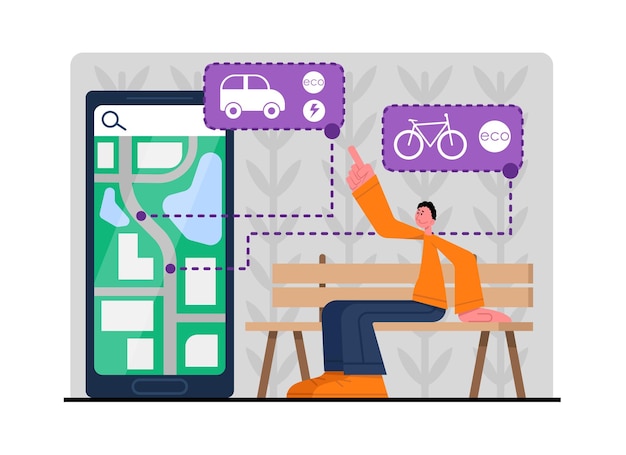Ground transportation apps have become integral to modern commuting, offering convenience and efficiency to users worldwide. With the rapid advancements in technology, developing a successful ground transportation app requires a strategic approach.
This comprehensive guide will delve into the essential aspects of ground transportation app development, focusing on key components, advanced features, best practices, and future trends.
Key Components of Ground Transportation App Development
User Experience and Interface Design
Designing an intuitive and user-friendly interface is crucial for any ground transportation app. The app should prioritize ease of navigation, ensuring that users can quickly book rides, view ride status, and manage their profiles without confusion.
Mobile responsiveness is essential, as users will access the app on various devices. A clean, simple design with clear call-to-action buttons and minimalistic layout enhances user satisfaction and retention.
Backend Infrastructure
The backend infrastructure of a ground transportation app plays a significant role in managing user requests and data. A robust backend ensures seamless operations, from handling ride requests to storing user data securely.
Technologies such as server management and database integration are critical for maintaining performance and scalability. Implementing a reliable backend system supports the app’s ability to handle high volumes of traffic and provide a smooth user experience.
Real-Time Tracking and Navigation
Real-time tracking and navigation are core features of a ground transportation app. Integrating GPS technology allows users to track their rides in real-time, providing transparency and enhancing trust. Route optimization and traffic updates help drivers find the quickest paths, reducing travel time and improving efficiency.
Real-time data benefits both users and drivers, ensuring timely arrivals and a better overall experience.
Payment Systems and Fare Management
Efficient payment systems and fare management are essential for any ground transportation app. Integrating secure payment gateways ensures that users can make transactions confidently. Features for fare calculation, invoicing, and discounts should be included to provide a transparent billing process.
Supporting multiple payment methods and currencies caters to a diverse user base, enhancing convenience and accessibility.
Advanced Features for Enhancing App Functionality
In-App Communication
In-app communication features enable users and drivers to connect directly without leaving the app. Options for in-app messaging and calls facilitate coordination and address any issues promptly.
Privacy considerations, such as masking phone numbers, protect user identities while maintaining communication efficiency. Real-time updates via in-app chat enhance the overall user experience and resolve potential conflicts quickly.
User and Driver Profiles
Comprehensive profiles for users and drivers build trust and accountability. Features for profile management, verification, and ratings allow users to review driver credentials and past performance. Drivers can also manage their profiles, including vehicle details and availability. Profile management is crucial for maintaining service quality and ensuring a reliable user experience.
Analytics and Reporting
Implementing analytics tools helps in tracking app performance and user engagement. Key metrics such as ride frequency, revenue, and user satisfaction provide valuable insights into app operations.
Analyzing data allows for informed decision-making and continuous improvement. Regular reporting helps identify trends, optimize service offerings, and enhance overall efficiency.
Integration with Third-Party Services
Integrating third-party services can extend the functionality of a transportation app like Uber. Examples include mapping services for enhanced navigation and customer support tools for resolving user queries.
API integration provides additional features and services, improving the app’s capabilities and user experience. Leveraging third-party services can also streamline operations and offer more comprehensive solutions.
Best Practices for Ground Transportation App Development
Choosing the Right Technology Stack
Selecting the appropriate technology stack is crucial for building a robust ground transportation app. Popular development frameworks such as React Native and Flutter offer cross-platform compatibility, reducing development time and cost. Backend technologies like Node.js and MongoDB support scalability and performance. Choosing modern frameworks and tools ensures a high-quality, efficient app.
Security and Compliance
Implementing robust security measures is essential to protect user data and maintain trust. Ensuring compliance with local and international regulations helps avoid legal issues and protects user privacy.
Data protection practices, such as encryption and secure storage, safeguard sensitive information. Prioritizing security and compliance is crucial for maintaining a reliable and trustworthy app.
Testing and Quality Assurance
Rigorous testing and quality assurance are vital for delivering a seamless user experience. Comprehensive testing strategies, including functional, performance, and security tests, help identify and address issues before launch. User feedback during the testing phase provides valuable insights for improvements. Continuous monitoring and regular updates post-launch ensure the app’s ongoing performance and reliability.
Marketing and User Acquisition
Effective marketing strategies are key to promoting your ground transportation app and acquiring users. Utilizing social media, search engine marketing, and referral programs can help reach a wider audience.
Engaging with users through feedback and providing excellent customer support enhance user retention and growth. Building a strong brand presence and offering incentives can drive user acquisition and foster loyalty.
Future Trends in Ground Transportation App Development
Emerging Technologies
Emerging technologies, such as AI and machine learning, are transforming ground transportation apps. Predictive analytics can optimize ride scheduling and improve route planning.
Autonomous vehicles and smart transportation solutions are on the horizon, offering innovative features and enhanced user experiences. Staying updated with these technologies ensures that your app remains competitive and cutting-edge.
Sustainability and Green Initiatives
Sustainability is becoming a key focus in transportation solutions. Integrating features to support eco-friendly practices, such as electric vehicle options and carbon footprint tracking, aligns with growing environmental concerns. Promoting green initiatives not only appeals to environmentally-conscious users but also contributes to a positive brand image and compliance with regulations.
Global Expansion and Localization
Expanding to new markets presents both challenges and opportunities. Localization is crucial for adapting the app to different cultures, languages, and regulations. Customizing features and services to meet local needs ensures a smooth market entry and enhances user satisfaction. Strategic planning and market research are essential for successful global expansion.
User-Centric Innovations
Future trends in user experience focus on personalization and innovation. Features such as AI-driven recommendations and customized ride options enhance user satisfaction.
Continuous innovation, including updates based on user feedback and technological advancements, keeps the app relevant and competitive. Embracing user-centric approaches ensures long-term success and growth.
Also read: How To Create A Successful Social Media Marketing Strategy?
Conclusion
In summary, ground transportation app development involves a multifaceted approach to meet modern commuting needs. By focusing on key components, advanced features, and best practices, businesses can create successful and efficient transportation solutions.
Staying informed about future trends and implementing innovative strategies will ensure the app’s success and relevance in the evolving mobility landscape. Embrace these practices to revolutionize ground transportation and deliver exceptional value to users.






Comments